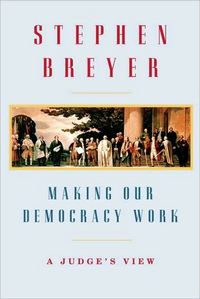

Purchase
Alfred a Knopf
September 2010
On Sale: September 14, 2010
288 pages
ISBN: 0307269914
EAN: 9780307269911
Hardcover
Add to Wish List
Non-Fiction
The Supreme Court is one of the most extraordinary
institutions in our system of government. Charged with the
responsibility of interpreting the Constitution, the nine
unelected justices of the Court have the awesome power to
strike down laws enacted by our elected representatives. Why
does the public accept the Court’s decisions as legitimate
and follow them, even when those decisions are highly
unpopular? What must the Court do to maintain the public’s
faith? How can the Court help make our democracy work? These
are the questions that Justice Stephen Breyer tackles in
this groundbreaking book. Today we assume that when the Court rules, the public will
obey. But Breyer declares that we cannot take the public’s
confidence in the Court for granted. He reminds us that at
various moments in our history, the Court’s decisions were
disobeyed or ignored. And through investigations of past
cases, concerning the Cherokee Indians, slavery, and Brown
v. Board of Education, he brilliantly captures the steps—and
the missteps—the Court took on the road to establishing its
legitimacy as the guardian of the Constitution. Justice Breyer discusses what the Court must do going
forward to maintain that public confidence and argues for
interpreting the Constitution in a way that works in
practice. He forcefully rejects competing approaches that
look exclusively to the Constitution’s text or to the
eighteenth-century views of the framers. Instead, he
advocates a pragmatic approach that applies unchanging
constitutional values to ever-changing circumstances—an
approach that will best demonstrate to the public that the
Constitution continues to serve us well. The Court, he
believes, must also respect the roles that other actors—such
as the president, Congress, administrative agencies, and the
states—play in our democracy, and he emphasizes the Court’s
obligation to build cooperative relationships with them. Finally, Justice Breyer examines the Court’s recent
decisions concerning the detainees held at Guantánamo Bay,
contrasting these decisions with rulings concerning the
internment of Japanese-Americans during World War II. He
uses these cases to show how the Court can promote workable
government by respecting the roles of other constitutional
actors without compromising constitutional principles. Making Our Democracy Work is a tour de force of history and
philosophy, offering an original approach to interpreting
the Constitution that judges, lawyers, and scholars will
look to for many years to come. And it further establishes
Justice Breyer as one of the Court’s greatest intellectuals
and a leading legal voice of our time.
No awards found for this book.
Comments
No comments posted.
Registered users may leave comments.
Log in or register now!
| 


 © 2003-2025 off-the-edge.net
all rights reserved Privacy Policy
© 2003-2025 off-the-edge.net
all rights reserved Privacy Policy